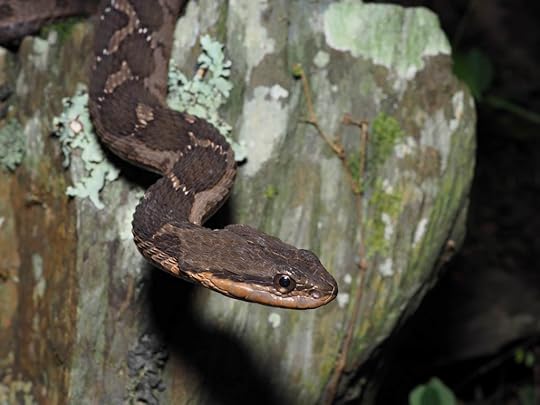Ripley Entertainment Inc.'s Blog, page 41
February 23, 2023
The Strange and Tragic Story of Kentucky’s ‘Cocaine Bear’
Featured in Ripley's Believe It or Not!

You don’t have to look far to find bizarre tourist attractions around the globe. San Luis Obispo, California, boasts Bubblegum Alley, where you can visit a 66-foot stretch of alleyway completely smattered with discarded chewing gum. In Japan, you can see the Hakone Kowakien Yunessun, a spa-themed park where tourists swim in steaming hot baths of green tea and sake. The Karni Mata Temple in Rajasthan, India, plays home to more than 20,000 rats. And in Boston, Massachusetts, there’s a house fabricated entirely from 100,000 sheets of newspaper, furniture included.
But, Believe It or Not!, this year’s buzziest (and kitschiest) roadside attraction is the Kentucky for Kentucky Fun Mall, home of the infamous “Cocaine Bear.” KY for KY has worked hard to preserve the story of Cocaine Bear and in doing so, has sparked inspiration for a new movie directed by Elizabeth Banks and starring Ray Liotta, Keri Russell, and Matthew Rhys.
Here’s what you need to know about the twisty real-life story behind Hollywood’s latest dark comedy.
From Narcotics Officer to Drug Kingpin and Failed ParachutistThe story of Cocaine Bear, also known as Pablo EskoBear, fittingly dates back to the 1980s and the so-called “Bluegrass Conspiracy.” Situated at the center of the chaos was Andrew Thornton, a Kentucky narcotics officer who turned over a new leaf as a drug kingpin. At the height of his second career, he flew a regular drug smuggling route between Colombia and the United States.
Untangling the intricate web he wove began on September 11, 1985, when Thornton’s body fell from the sky onto a driveway in Knoxville, Tennessee. Besides the parachute he appeared to have gotten tangled up in, Thornton carried 150 pounds of cocaine and brandished a bulletproof vest, a Miami Jockey Club membership card, night vision goggles, and Gucci loafers. He also proved well-armed with at least two guns, a few knives, a key to the plane, and $4,500 in cash.
Thornton died at 40 years old, and his exit proved spectacular. Sixty miles from Thornton’s landing point, debris from his plane turned up. Investigators hypothesized he put the aircraft on autopilot before jumping. Some believe he hit his head on the airplane’s tail, inadvertently knocking himself unconscious on the ride to the ground, while others believe the parachute failed. Either way, the ride down proved fatal, but it wouldn’t be the end of the drug kingpin’s legacy.
A Bizarre Find in Chattahoochee National ParkAs investigators researched and pieced together exactly what happened to the drug-runner-turned-failed-parachutist, another story unfolded in Georgia’s Chattahoochee National Forest. It involved a hunter who stumbled across a bizarre scene: a 175-pound black bear found dead next to an empty duffel bag of cocaine. A necropsy determined the bear died while consuming 75 pounds of the drug! The white powder measured 95 percent pure and filled the bear’s tummy “to the brim.”

Image Credit: Kentucky for Kentucky.
Causes of death discovered during the autopsy included respiratory failure, hyperthermia, renal failure, stroke, and cerebral hemorrhaging. As the official who performed the autopsy reported, “There isn’t a mammal on the planet that could survive that …. You name it, that bear had it.” Despite the messy death, however, the bear’s body remained remarkably intact, which is where the Cocaine Bear story takes another unexpected twist.
A Remarkable, Post-Mortem JourneyCocaine Bear’s remarkably handsome state of preservation motivated locals to have him stuffed and donated to the Chattahoochee River National Recreation Area’s Visitor Center. From there, Cocaine Bear went into storage during a wildfire before reappearing in a Nashville pawn shop.
The bear caught the eye of famed country singer and songwriter Waylon Jennings, who purchased the ursine, gifting it to his friend, Ron Thompson of Las Vegas, Nevada. Thompson died in 2009, and the bear moved to Reno, purchased from Thompson’s estate by Zhu T’ang, who displayed it in his Chinese medicine shop for years.
In 2015, Kentucky for Kentucky tracked down the long-lost taxidermy Bear and brought him to the KY for KY Fun Mall in Lexington, Kentucky. KY for KY went on to state, “Bringing joy to thousands of people every month, Cocaine Bear is not just a roadside attraction – and soon-to-be biopic anti-hero – he’s also a city mascot, a heartwarming community builder, and a warning to all on the dangers of drug abuse.”
Cocaine Bear has been an online viral sensation landing on the front page of Reddit multiple times in just a couple of years and earning over 150,000 combined upvotes! Various blogs, newspapers, TV news stations, and YouTube channels have gone on to cover Cocaine Bear and Believe It or Not!, when renowned podcast “My Favorite Murder” produced an animated short based on Cocaine Bear, it caught the attention of comedian, and voice actor Patton Oswalt!
Oh my God I want to do the voice of Cocaine Bear. https://t.co/5l5YdaVZ2d
— Patton Oswalt (@pattonoswalt) January 23, 2019
Today, Cocaine Bear enjoys a renewed life as a roadside celebrity that’s surprisingly family-friendly. Is it weird that a bear that died of a drug overdose is now a favorite children’s attraction? Perhaps. But the cocaine-addled teddy also acts as a fitting deterrent to illicit substances. As the sign around the animal’s neck explains, “Don’t do drugs or you’ll end up dead (and maybe stuffed) like poor ‘Cocaine Bear.’”
Be sure to check out KY for KY on Instagram, Twitter, Facebook and YouTube for more Cocaine Bear content and stories. Looking for Cocaine Bear merch to wear to the February 24th big-screen debut? Checkout the KY for KY online store and grab an original Cocaine Bear commemorative item!
By Engrid Barnett, contributor for Ripleys.com
EXPLORE THE ODD IN PERSON! Discover hundreds of strange and unusual artifacts and get hands-on with unbelievable interactives when you visit a Ripley’s Odditorium!Source: The Strange and Tragic Story of Kentucky’s ‘Cocaine Bear’
CARTOON 02-23-2023
February 22, 2023
Poison Control: Could Humans Become Venomous?
Featured in Ripley's Believe It or Not!

Poison Ivy. Spider-Man 2099. Omega Red. These toxic comic book characters use poison-based attacks to defeat their opponents. But can mere mortals be capable of the same deadly skill? Scientists think so, as new research has revealed that humans have the genetic bedrock needed to spit venom!
Toxicity is Written in Our GenesScientists from the Okinawa Institute of Science and Technology Graduate University (OIST) and the Australian National University recently conducted a study to learn how venom glands evolve in animals.
Countless creatures spanning multiple species produce oral venom, including snakes, spiders, and even shrews. But while most mammals—including people—aren’t venomous, the study found that any animal with salivary glands has the potential to become toxic.
The team made this discovery by studying venom-producing tissue in Taiwan habu vipers. They focused on 3,000 genes that work alongside venomous ones. These “cooperating” genes protect cells from stress and manage protein folding and modification.

Scientists found the same genes and molecular mechanisms in mammals, including mice, dogs, and even humans!
“While many snakes employ an oral venom system for securing prey, there are also mammals, such as shrews and solenodons, that have evolved oral venom systems (based on salivary glands) for prey capture or defense. Therefore, the overall conservation of metavenom network expression, as well as preservation of the metavenom network module, suggests that salivary glands in mammals and venom glands in snakes share a functional core that was present in their common ancestor. Using this common molecular foundation as a starting point, snakes diversified their venom systems by recruiting a diverse array of toxins, while mammals developed less complex venom systems with high similarity to saliva. Developing similar traits using common molecular building blocks is the hallmark of parallelism,” the study, published in PNAS, states.
Will People Become Poisonous?Many mammals have evolved to make oral venom, including platypuses, vampire bats, and slow lorises. But while humans produce essential proteins present in many venomous systems, evolution has yet to lead us down a poisonous path.
The animals that have evolved to produce venom did so to overpower prey or defend themselves. The way venom evolves directly correlates to how animals live. Humans, on the other hand, have developed the necessary tools and skills to feed and defend ourselves without requiring venom.
Surprisingly, experiments conducted in the 1980s found that male mice can produce proteins in their saliva that are deadly to rats. So, although highly unlikely, humans could evolve to create venom under the right ecological conditions.
If 2020 taught us anything, humans are highly adaptable beings. We pulled through a global pandemic. So maybe, just maybe, we’re capable of developing poisonous fangs.
By Steph Weaver, contributor for Ripleys.com
EXPLORE THE ODD IN PERSON! Discover hundreds of strange and unusual artifacts and get hands-on with unbelievable interactives when you visit a Ripley’s Odditorium!CARTOON 02-22-2023
February 21, 2023
Find Hot Moons in Your Area: The Search for Planet Nine
Featured in Ripley's Believe It or Not!

In 2006, the International Astronomical Union (IAU) officially demoted Pluto from the beloved ninth planet to one of five dwarf planets; the universe hasn’t felt the same since. An impressive backlash followed, still brewing within the scientific community.
Ten years later, an article in The Astronomical Journal argued for the existence of Planet Nine because of the altered orbits of nearby space bodies (e.g., comets, asteroids, moons, dwarf planets, etc.). Essentially, something significant acts on their gravity, although it sits too far from the sun to be seen via solar light rays.
Now, a new study may set the stage for Planet Nine’s discovery, hypothesizing that roughly 20 superheated moons orbit it. Seeing these tiny satellites would prove impossible. But due to their high temperatures, one researcher believes they give off weak radio signals capable of telescopic detection. As a result, some astronomers have launched a hunt for hot moons in our area (of the galaxy).
The Outer Solar System’s Massive Ice GiantWhile the thought of a giant Planet Nine orbiting at the edge of our solar system might sound sensational (and unthinkable), some believe science firmly backs it. They include Konstantin Batygin of Cal Tech and Mike Brown of the California Institute of Technology, co-writers of the 2016 Planet Nine hypothesis. Brown explains, “It’s not crazy; this is the kind of stuff people are finding all the time. We just need to go out and cover a good swath of the sky.”
Where does Pluto fit into all of this? Everyone’s favorite dwarf planet also sits at the Kuiper Belt’s edge, but it doesn’t have the gravitational pull to explain what’s happening with affected space objects in the area. And Batygin and Brown determined that the solar system’s other giant planets all prove too far away to be culprits. The apparent conclusion? A ninth planet may lurk in the farthest corners of our galaxy.
What We Know About So-Called Planet NineIf Planet Nine does exist, what do we know about it so far? Scientists estimate it could be between five and ten times the mass of Earth. Moreover, they’ve proposed an elongated orbit for the giant that travels up to 400 times our planet’s distance from the sun. They also believe that, unlike most planets in our solar system, the ice giant may sit 15 to 25 degrees off the main orbital plain.
But these revelations have done little to prove the actual existence of the planet. (Some scientists even claim Planet Nine is a black hole.) To date, the most damaging indictment against the planet remains a total lack of light signatures. But considering its distance from the sun, astronomers who support the Planet Nine theory aren’t surprised.
Why Superheated Moons May Change EverythingUntil recently, scientists assumed the only way to prove Planet Nine’s existence was through its eclipse of a distant light source. Think a star or galaxy within the Milky Way. That’s why the recent theory about superheated moons giving off faint radio signals proves so exciting. After all, if scientists know what to look for, they can attune telescopes accordingly.

Radio satellite dishes used to pick up faint signals. via Shutterstock
Detecting these signals would prove easier than crossing our fingers and hoping for an eclipse. Man Ho Chan of the University of Hong Kong developed the superheated moon theory by calculating the maximum number of satellites Planet Nine might support. His final figure came in at 20 moons, measuring up to 62 miles across — small beans for astronomers squinting through telescopes. But, nonetheless, a trail of potential planetary breadcrumbs.
Tidal Heating, Radio Signals, and the Fate of PlutoThankfully, Planet Nine’s gravitational pull may provide more clues to its existence through a phenomenon known as tidal heating. We know about tidal heating because of Jupiter’s moon, Io, featuring a highly molten core fueled by the intense gravitational tug-of-war it endures with Jupiter and the planet’s other moons.
If Planet Nine does exist, and tiny moons orbit it, they would be subject to tidal heating, too. Chan estimates their temperatures might come in at approximately 280 degrees Fahrenheit. Compared to the average temperature of outer space, -455 degrees Fahrenheit, that’s a significant temperature increase. Heated to these extremes, the moons would emit radio signals, providing clear evidence of their existence and the giant they circle.
If and when Planet Nine’s hot moons get discovered via radio signals, this begs the question, what should we name it? Astronomers tend to prize consistency and tradition, hence the multi-generational use of Greek and Roman god and goddess monikers (e.g., Venus, Mars, Neptune). But is already lobbying to stick with “Planet Nine,” which would buck trends but has a certain ring to it. Moreover, a title like Planet Nine allows poor, diminutive Pluto to remain forever in our hearts if not in our solar system’s giant planets model.
By Engrid Barnett, contributor for Ripleys.com
EXPLORE THE ODD IN PERSON! Discover hundreds of strange and unusual artifacts and get hands-on with unbelievable interactives when you visit a Ripley’s Odditorium!Source: Find Hot Moons in Your Area: The Search for Planet Nine
CARTOON 02-21-2023
February 20, 2023
CARTOON 02-20-2023
February 19, 2023
CARTOON 02-19-2023
February 18, 2023
CARTOON 02-18-2023
February 17, 2023
Ripley’s Round Trip: Seriously Weird Travel Destinations
Featured in Ripley's Believe It or Not!

We have an island run by cats, an eerie network of tombs underneath Paris and the world’s deadliest hiking trail. On the first episode of Ripley’s Round Trip we’re taking you across the globe to check out some “seriously weird” travel destinations. Who knows it may just inspire your next adventure!
A Purr-fect DestinationBeginning first with Tashirojima, an island off the coast of Japan where less than 25% of its population are human! Nicknamed “cat island”, this land was used as a center for silkworm production for textiles, but in order to keep the cocoons safe from rats and mice, they imported a few cats to fix the problem. Well, these fluffy guards were allowed to roam freely which resulted in them eventually outnumbering the less than 100 human residents. If you decide to make your way to the Isle of Cats, here’s a tip, there’s no need to bring them any food or treats no matter how tempting it may be. Locals say these cats are thought to bring good luck and fortune so they are well taken care of with plenty of food, water and cuddles.
A Tourist Hot Spot
A group of orange cats in Tashirojima(cat island), Japan. pic.twitter.com/1X4gFB2KjP
— Travel Art (@Travel_artz) December 21, 2020
We only flame to please with our next seriously weird destination over in Turkmenistan. Famously called the Gates of Hell, the Darvaza Gas Crater has attracted more and more tourists each year with its massive pit of fire that has been burning in the Karakum desert for more than five decades. This Gas Crater is reported to have formed around 1971 while Soviet geologists were exploring for oil and natural gas. When they began drilling they quickly realized they had penetrated a giant underground cavern when the ground beneath their equipment began to subside. Well, If you’re feeling extra courageous on your next trip, be sure to stop by and witness the incredible fiery abyss for yourself!

Credit: Benjamin Goetzinger Via Wikimedia Commons (CC BY-SA 4.0).
Hellacious HikeFeeling extra adventurous? At the end of this treacherous death-defying trail in China is a mere tea house, but this Mount Huashan Plank Walk is famed for its adrenaline-raising effects and dubbed the deadliest hiking trail in the world. Hikers ascend the mountain by walking across a few planks of wood bolted into the side of a 7,000-foot peak in order to reach a small shrine and while the hikers are harnessed, it is still a bizarre and terrifying adventure in the sky. Would you walk the plank here, at one of the strangest destinations on earth? Let us know in the comments below.
Catacomb Craze
Crazy Mount Huashan hike, also known as the ‘world’s most dangerous hike’, or the ‘plank walk’, in China. Would you dare to walk on these wooden planks bolted to the side of a cliff, 2000 feet in the air? pic.twitter.com/FIEvNnr9nS
— Camping Expedition (@Camping123456) October 24, 2019
Our last location lurks deep below the city of Paris, and is one of the most unbelievable places I’ve ever experienced, and one that I recommend having a strong stomach for. Once you’ve finished marveling at the Eiffel Tower or strolling along the Champs-Élysées, don’t forget to make your way down to the Catacombs of Paris. Believe It or Not!, this network of tombs lies directly underneath the city and is home to the remains of over six million bodies. What?! What started as a solution to relieve the city’s overflowing cemeteries turned into a hotspot for tourists everywhere and there’s no feeling quite like being deep underground in the dark and surrounded by millions of skeletons. Keep in mind, there are no elevators down to this area so you will be making the 131 step descent by foot.

Credit: Tommie Hansen Via Wikimedia Commons (CC BY-SA 2.0).
Well explorers, we hope you’ve enjoyed these seriously weird travel destinations and maybe it’s inspired you to add some to your own travel list. This concludes the first episode of our brand new series, Ripley’s Round Trip, where we’re following the footsteps of our favorite explorer Robert Ripley as we take you around the world to experience the best and the bizarre of the travel world. Until next time, happy adventuring!
EXPLORE THE ODD IN PERSON! Discover hundreds of strange and unusual artifacts and get hands-on with unbelievable interactives when you visit a Ripley’s Odditorium!Source: Ripley’s Round Trip: Seriously Weird Travel Destinations
Ripley Entertainment Inc.'s Blog
- Ripley Entertainment Inc.'s profile
- 52 followers









